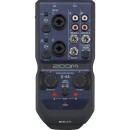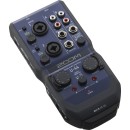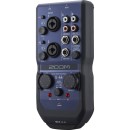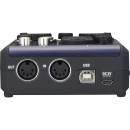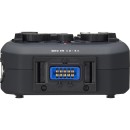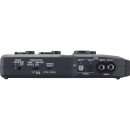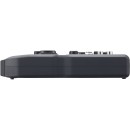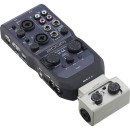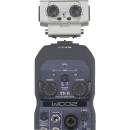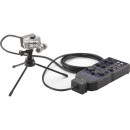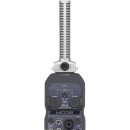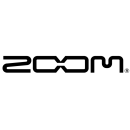Zoom U-44 Portable 4x4 USB Handy Audio/MIDI Interface Review
- 4-in/4-out audio interface with high-quality, low-noise mic preamps.
- Compatible with PC, Mac, and iPad.
- Supports 24-bit/96 kHz audio resolution.
- Includes two combo inputs with Hi-Z support for guitars and basses.
- Dedicated MIDI input and output connectors.
- Dual balanced TRS outputs for connection to monitor speakers.
- S/PDIF digital input and output.
- Bus-powered from USB or with optional power adapter.
- Compact and rugged design for portability.
- Includes Cubase LE software for recording and editing.
Product Specifications and Detailed Review
The Zoom U-44 Portable 4x4 USB Handy Audio/MIDI Interface is a compact, versatile device designed for professional audio recording and production on the go. It features a 4-in/4-out configuration, allowing you to connect multiple instruments, microphones, and other audio sources simultaneously. The U-44 supports high-resolution audio up to 24-bit/96 kHz, ensuring pristine sound quality for your recordings.
Equipped with Zoom's high-quality mic preamps, the U-44 delivers clear, transparent audio, making it suitable for a range of applications including podcasting, music production, and live streaming. The interface includes two combo inputs with dedicated gain knobs, phantom power for condenser mics, and Hi-Z inputs for direct connection of guitars and basses. Additionally, it has MIDI In/Out ports for connecting synthesizers, drum machines, and other MIDI devices.
The U-44 is powered via USB, making it highly portable and convenient for mobile setups. It also features a rugged, durable design to withstand the rigors of travel. With its flexible connectivity options and superior audio quality, the Zoom U-44 is an excellent choice for musicians, podcasters, and audio professionals seeking a reliable and portable recording solution.
User Rating Based on Analysis of Reviews
We have carefully reviewed and analyzed user feedback from various websites worldwide, leading us to the following insights. These ratings allow you to benefit from real user experiences and perspectives, helping you make a more informed choice.
Purchase Value
85% of users were satisfied with the purchase value of the Zoom U-44 Portable 4x4 USB Handy Audio Interface. They appreciated the affordable price point for the range of features offered, including multiple input/output options and compatibility with various audio equipment. Many users felt that it delivered professional-quality audio without the need for more expensive equipment, making it a cost-effective solution for musicians and audio producers.
15% of users expressed dissatisfaction with the purchase value, citing that the device did not meet their expectations in terms of performance and features compared to other similarly priced audio interfaces. Some users reported issues with the build quality and durability, feeling that the product did not justify its cost over time.
Quality of Materials
70% of users were satisfied with the quality of materials used in the Zoom U-44. They found the interface to be robust and durable, with a solid build that could withstand regular use. The compact design was also praised for its portability, making it suitable for on-the-go recording sessions.
30% of users were not satisfied with the quality of materials, highlighting concerns over the plastic components that felt cheap and prone to wear and tear. Some users reported issues with the knobs and connectors becoming loose over time, which raised concerns about the long-term reliability of the device.
Ease of Use
75% of users found the Zoom U-44 to be user-friendly, appreciating the straightforward setup and intuitive interface that allowed them to start recording quickly. The clear labeling of inputs and controls made it accessible even for those new to audio interfaces.
25% of users found the device challenging to use, particularly when integrating it with other audio software and hardware. Some users experienced difficulties with driver installation and connectivity issues, which hindered their ability to fully utilize the device's capabilities.
Sound Quality
80% of users were pleased with the sound quality provided by the Zoom U-44. They noted that the interface delivered clear and professional audio output, with minimal latency and excellent preamp quality, which was crucial for high-quality recordings.
20% of users were dissatisfied with the sound quality, mentioning issues such as background noise and interference. They felt that the audio interface did not provide the level of clarity and fidelity expected for studio-grade recordings, especially when used in more demanding audio environments.
Portability
90% of users praised the portability of the Zoom U-44, highlighting its compact size and lightweight design, which made it easy to carry and set up in various locations. This feature was especially appreciated by musicians and producers who frequently travel for gigs or recording sessions.
10% of users found the portability aspect lacking, mainly due to the need for additional cables and accessories, which could be cumbersome to manage. Some also mentioned that the battery life was not sufficient for extended use when away from power sources.
Compatibility
75% of users were satisfied with the compatibility of the Zoom U-44, as it worked seamlessly with multiple operating systems and audio software. Users appreciated the ability to connect various instruments and microphones without issue, enhancing their recording versatility.
25% of users experienced compatibility issues, particularly with certain DAWs and operating systems. These users reported needing to download additional drivers or software updates, which complicated the setup process and delayed their recording sessions.
Durability
65% of users found the Zoom U-44 to be durable, withstanding regular use and transportation without significant wear. They appreciated the sturdy construction that ensured longevity, particularly for those who used it frequently in different environments.
35% of users were dissatisfied with the durability, citing issues such as physical wear and tear, and components like knobs and ports becoming loose. Some reported that the device stopped functioning after a few months of use, questioning its long-term reliability.
Customer Support
60% of users had a positive experience with customer support, finding the representatives to be helpful and responsive when addressing their queries and issues. They appreciated the availability of online resources and prompt assistance.
40% of users were dissatisfied with the customer support, mentioning delayed responses and inadequate solutions to their problems. Some users felt that the support team lacked technical knowledge, which hindered their ability to resolve complex issues.
Connection Options
80% of users were satisfied with the wide range of connection options available on the Zoom U-44, including USB, MIDI, and various input/output ports. This versatility allowed them to connect multiple devices simultaneously, enhancing their recording setup.
20% of users expressed dissatisfaction with the connection options, noting that some ports were prone to connectivity issues and required frequent adjustments. They also mentioned that certain connections did not work as expected with some older audio equipment, limiting their setup flexibility.
Driver Stability
70% of users were satisfied with the driver stability of the Zoom U-44, finding that the drivers were reliable and frequently updated to ensure compatibility with the latest software and operating systems. This stability was crucial for uninterrupted recording sessions.
30% of users reported dissatisfaction with driver stability, experiencing frequent crashes and disconnections during use. These issues disrupted their workflow and required frequent troubleshooting, which was frustrating for users relying on the interface for professional work.
Latency Performance
75% of users were satisfied with the latency performance of the Zoom U-44, noting minimal delay during recording and playback, which was essential for live performances and studio work. This low latency contributed to a seamless recording experience.
25% of users faced issues with latency, experiencing noticeable delays that affected the timing and quality of their recordings. These users found the latency unacceptable for professional-grade audio production, requiring them to seek alternative solutions.
Preamp Quality
80% of users praised the preamp quality of the Zoom U-44, highlighting its ability to deliver clear and powerful audio signals with minimal distortion. This quality was particularly valued by musicians and vocalists seeking high-fidelity recordings.
20% of users were dissatisfied with the preamp quality, mentioning issues such as noise interference and lack of sufficient gain. These problems affected the overall audio quality, making it challenging to achieve the desired sound output.
Aesthetic Design
85% of users were satisfied with the aesthetic design of the Zoom U-44, appreciating its sleek and modern look, which complemented their audio equipment setup. The design was also noted for its practicality, with an intuitive layout that facilitated easy use.
15% of users expressed dissatisfaction with the design, finding it too simplistic and lacking in unique features that set it apart from other interfaces. Some users also mentioned that the labeling on the device was not clear enough, which led to confusion during use.
Power Supply Options
70% of users were satisfied with the power supply options, appreciating the flexibility of using either USB power or batteries, which allowed for use in various settings without relying on a constant power source.
30% of users were dissatisfied with the power supply options, noting that the battery life was insufficient for prolonged use and required frequent replacements. Some also mentioned issues with the USB connection providing inconsistent power, leading to interruptions.
User Manual Clarity
65% of users found the user manual to be clear and helpful, providing detailed instructions and troubleshooting tips that assisted them in setting up and using the Zoom U-44 effectively.
35% of users expressed dissatisfaction with the user manual, criticizing it for being poorly organized and lacking in-depth explanations for advanced features. This lack of clarity forced some users to seek additional online resources to fully understand the device's capabilities.
Software Bundles
60% of users appreciated the software bundles included with the Zoom U-44, finding them useful for enhancing their audio production capabilities and providing a good starting point for beginners in audio editing.
40% of users were dissatisfied with the software bundles, feeling that they were outdated or limited in functionality. Some users also reported compatibility issues with their existing software, which limited their ability to integrate the new tools into their workflow.
Learning Curve
75% of users found the learning curve for the Zoom U-44 to be manageable, appreciating the intuitive design and straightforward setup that allowed them to quickly become familiar with its functions.
25% of users struggled with the learning curve, particularly when it came to understanding more advanced features and settings. These users felt that additional tutorials or guides would have been helpful in easing their transition to using the device.
Recording Flexibility
85% of users were satisfied with the recording flexibility offered by the Zoom U-44, valuing its ability to handle various recording scenarios and accommodate different audio sources simultaneously. This flexibility was essential for users who required a versatile setup.
15% of users found the recording flexibility lacking, particularly when it came to handling more complex setups that required additional inputs and outputs. Some users noted that the device's limitations hindered their ability to expand their recording capabilities.
Firmware Updates
70% of users appreciated the firmware updates provided for the Zoom U-44, which helped resolve existing issues and improve performance. Regular updates ensured that the device remained compatible with the latest audio technologies.
30% of users were dissatisfied with the firmware updates, mentioning that they were infrequent and sometimes introduced new bugs. This inconsistency led to frustration, as users had to wait for further updates to address these new issues.
Overall User Experience
80% of users reported a positive overall experience with the Zoom U-44, highlighting its reliability, sound quality, and ease of use as key factors that contributed to their satisfaction. It was seen as a valuable addition to their audio setup.
20% of users were dissatisfied with their overall experience, mainly due to technical issues and limitations that affected their ability to fully utilize the device's features. These users felt that the product did not meet their expectations, leading them to consider alternative options.
In this section, we will thoroughly examine the specifications of the Zoom U-44 Portable 4x4 USB Handy Audio/MIDI Interface. We will also take a close look at the advantages and disadvantages of this product, providing you with an in-depth understanding of its performance and features.
Pros:
- Compact and portable design, ideal for mobile recording.
- Versatile connectivity options including XLR/TRS combo inputs, MIDI I/O, and S/PDIF.
- High-quality preamps and converters for clear audio capture.
- Standalone AD/DA conversion capability.
- Compatible with iOS devices using the Apple Camera Connection Kit.
Cons:
- Limited to 24-bit/96kHz resolution, which may not meet the needs of all users.
- Build quality might not be as robust as higher-end interfaces.
- Included software bundle is relatively basic.
- Requires external power supply for certain functions, reducing portability.
General
| Channels of I/O | Analog: 2 Inputs / 4 Outputs Digital: 2 Inputs / 0 Outputs |
|---|---|
| Built-In DSP | |
| Maximum Sampling Rate | 48 kHz / 24-Bit |
| Number of Microphone Inputs | 2 Preamps |
| Built-In Microphone | |
| Input Level Adjustment | 2x Knob |
| Expansion Slots |
The specifications for the Zoom U-44 Portable 4x4 USB Handy Audio/MIDI Interface provide essential details about its functionality and performance capabilities. Show More
Channels of I/O: This feature indicates the number of input and output channels available on the device. The U-44 has 2 analog inputs and 4 outputs, along with 2 digital inputs. This configuration allows for versatile audio routing and the ability to connect multiple audio sources and outputs, making it suitable for various recording and live sound applications.
Built-In DSP: The U-44 does not include built-in Digital Signal Processing (DSP). DSP capabilities can enhance audio quality by applying effects and processing in real-time. The absence of DSP means users will need to rely on external processing solutions for effects like reverb or compression.
Maximum Sampling Rate: This specification refers to the highest audio quality the interface can handle, which is 48 kHz at 24-bit resolution. A higher sampling rate allows for more detail in audio recordings, making it suitable for professional-grade recordings. The 48 kHz rate is standard for many applications, ensuring good sound quality for both music production and podcasting.
Number of Microphone Inputs: The U-44 features 2 preamps for microphone inputs. This allows users to connect two microphones simultaneously, making it ideal for interviews, podcasts, or recording multiple vocal tracks at once. The quality of the preamps will affect the clarity and fidelity of the recordings.
Built-In Microphone: The U-44 does not come with a built-in microphone. This means users must provide their own microphones, which can be an advantage for those seeking specific microphone types or brands to suit their recording needs.
Input Level Adjustment: This feature includes 2 knobs for adjusting the input levels. This allows users to control the volume of the incoming audio signals, ensuring optimal recording levels without distortion. Proper level adjustment is crucial for achieving high-quality recordings.
Expansion Slots: The absence of expansion slots means the U-44 does not support additional hardware upgrades or add-ons. While this limits customization, the interface is designed to be compact and portable, focusing on providing essential features without the need for extra components.
Signal Processing
| Pad | |
|---|---|
| Gain/Trim Range | Inputs: 0 to 43 dB |
| High-Pass Filter | |
| Solo/Mute | Mute per Master |
The specifications of the Zoom U-44 Portable 4x4 USB Handy Audio/MIDI Interface provide essential insights into its functionality and performance capabilities.Show More
The Pad feature indicates whether the interface includes a pad function, which is used to reduce the input level of audio signals. In this case, the absence of a pad means that the user has to be cautious with high-level signals, as there’s no built-in option to attenuate those levels before they reach the interface’s preamps.
Next, the Gain/Trim Range specifies the adjustable input gain levels for the device, in this instance ranging from 0 to 43 dB. This range is crucial as it allows users to amplify weak signals or adjust the level of louder sources to achieve optimal recording levels without distortion. A wider gain range can provide more flexibility in various recording scenarios.
The High-Pass Filter feature is typically used to eliminate low-frequency noise or rumble from recordings. The absence of a high-pass filter means that users will need to apply such filtering in post-production if needed, which can be a consideration for those working in environments with significant low-frequency interference.
Finally, the Solo/Mute functionality, which is set to mute per master, allows users to silence the entire mix when needed. This is particularly useful during live performances or recordings where isolating certain tracks is necessary for monitoring or adjustments. The lack of individual solo capabilities may require more manual management during mixing sessions.
Together, these specifications highlight the practical capabilities and limitations of the Zoom U-44, guiding users in how to utilize the interface effectively for their audio projects.
Connectivity
| Analog Audio I/O | 1x Combo XLR-1/4" TRS Balanced/Unbalanced Mic/Line/Hi-Z Input 1x Combo XLR-1/4" TRS Balanced/Unbalanced Mic/Line Input 2x 1/4" TRS Balanced Monitor Output 2x Stereo RCA Coaxial Unbalanced Line Output 1x 1/4" TRS Unbalanced Headphone Output |
|---|---|
| Phantom Power | 48 V, Selectable On/Off (Applied to All Inputs) |
| Digital Audio I/O | 1x RCA Coaxial S/PDIF Input 1x RCA Coaxial S/PDIF Output 1x TOSLINK Optical S/PDIF Input 1x XLR 3-Pin S/PDIF Output |
| Host Connection | 1x USB-B (Class-Compliant) |
| Host Connection Protocol | USB 2.0 |
| USB (Non-Host) | 1x Micro-USB (Power Input) |
| Sync I/O | |
| Network I/O | |
| MIDI I/O | 1x DIN 5-Pin Input 1x DIN 5-Pin Output |
| Other I/O | 1x Proprietary/Zoom 10-Pin Mic Module Input |
| Wireless |
The Zoom U-44 Portable 4x4 USB Handy Audio/MIDI Interface offers a comprehensive set of specifications that cater to various audio recording and MIDI needs. Show More
Analog Audio I/O refers to the interface's ability to handle audio signals in their analog form. The U-44 includes multiple input and output options, such as combo XLR/TRS inputs for microphones and instruments, balanced monitor outputs, and unbalanced line outputs. This variety allows users to connect different audio sources, whether they are instruments, microphones, or studio monitors, providing flexibility in both recording and playback scenarios. The inclusion of a headphone output also allows for direct monitoring of audio.
Phantom Power is essential for powering condenser microphones, as it provides the necessary voltage to operate these mics. The U-44 features selectable 48 V phantom power that can be applied to all inputs, ensuring that users can utilize high-quality microphones without needing separate power sources.
Digital Audio I/O indicates the interface's capabilities for digital audio connections, which are crucial for high-quality sound transmission. The U-44 supports both S/PDIF coaxial and optical inputs and outputs, allowing for seamless integration with digital audio equipment. This is particularly beneficial for users who want to connect to digital mixers or other audio interfaces without compromising audio quality.
Host Connection and Host Connection Protocol detail how the U-44 connects to computers and other devices. With a USB-B connection compliant with USB 2.0 standards, users can easily connect the interface to their computers for recording and playback. Additionally, the Micro-USB power input ensures that the device can be powered via various sources.
MIDI I/O allows for communication between the U-44 and MIDI devices, such as keyboards or controllers. This feature includes both MIDI input and output via standard DIN connectors, enabling users to record MIDI data and control software instruments or hardware synthesizers.
Overall, the Zoom U-44 provides a versatile solution for audio recording and MIDI integration, making it suitable for musicians, podcasters, and audio engineers alike. Its range of input and output options, along with digital connectivity and MIDI capabilities, enhances its functionality as a portable audio interface.
Performance
| Frequency Response | System: 20 Hz to 20 kHz ±1.5 dB (at 44.1 kHz) 20 Hz to 40 kHz ±2 dB (at 96 kHz) |
|---|---|
| Maximum Input Level | Line Inputs: +20.7 dBu Mic Inputs: +2.7 dBu |
| Maximum Output Level | 1/4" Monitor Outputs: +10 dBu at 0 dBFS RCA Line Outputs: +8 dBu at 0 dBFS RCA Headphone Outputs: +10 dBu at 0 dBFS |
| Headphone Output Power | 30 mW per Channel into 32 Ohms |
| Impedance | Combo XLR-1/4" Mic Inputs: 2.6 Kilohms Combo XLR-1/4" Hi-Z Inputs: 1.1 Megohms 1/4" Monitor Outputs: 330 Ohms RCA Line Outputs: 1 Kilohm Stereo RCA Headphone Outputs: 33 Ohms |
| EIN | Inputs: -119.5 dBA (150-Ohm Source) |
The specifications of the Zoom U-44 Portable 4x4 USB Handy Audio/MIDI Interface provide a comprehensive overview of its audio performance and capabilities. Show More
Starting with **Frequency Response**, this indicates the range of frequencies the device can effectively reproduce. The U-44 has a frequency response of 20 Hz to 20 kHz at 44.1 kHz sampling rate, ensuring it covers the full audible spectrum for most users. At a higher sampling rate of 96 kHz, the response extends to 40 kHz, which is beneficial for high-resolution audio recordings, allowing for more detailed sound reproduction.
**Maximum Input Level** refers to the highest level of signal that the device can handle without distortion. The U-44 can manage +20.7 dBu on line inputs and +2.7 dBu on mic inputs, indicating its ability to accommodate both high-level signals from instruments and lower-level signals from microphones, making it versatile for various recording scenarios.
In terms of **Maximum Output Level**, this specification shows the peak output levels the U-44 can deliver. The monitor outputs can reach +10 dBu, while RCA line outputs can achieve +8 dBu, and headphone outputs can also reach +10 dBu. These values are important for ensuring that the interface can provide sufficient signal strength to connected devices, enabling clear audio playback without distortion.
The **Headphone Output Power** of 30 mW per channel into 32 Ohms indicates the power available for driving headphones. This level of output power ensures that users can achieve a good volume level without experiencing audio quality loss, making it suitable for both casual listening and critical monitoring.
**Impedance** values for various inputs and outputs define the resistance of the device to incoming or outgoing signals. For instance, the combo XLR-1/4" mic inputs have an impedance of 2.6 Kilohms, which optimizes compatibility with most microphones, while the Hi-Z inputs have a higher impedance of 1.1 Megohms, making them ideal for high-impedance instruments like electric guitars.
Lastly, **EIN (Equivalent Input Noise)** measures the amount of background noise that the device generates at its inputs, with a value of -119.5 dBA for a 150-Ohm source being exceptionally low. This means that the U-44 has excellent noise performance, allowing for cleaner recordings by minimizing unwanted noise interference.
Overall, these specifications highlight the Zoom U-44's ability to handle a wide range of audio tasks, making it an excellent choice for musicians, podcasters, and audio engineers alike.
Digital Audio
| Sample Rates | 44.1 / 48 / 88.2 / 96 kHz |
|---|---|
| Sample Rate Conversion | |
| Bit Depths | 24-Bit |
| Latency | Zero-Latency Direct Monitoring |
| Sync Sources | Internal, S/PDIF |
The specifications of the Zoom U-44 Portable 4x4 USB Handy Audio/MIDI Interface highlight its capabilities and performance characteristics, which are crucial for audio recording and production. Show More
Sample Rates: The device supports sample rates of 44.1, 48, 88.2, and 96 kHz. Sample rates determine how many times audio is sampled per second, which directly affects the fidelity of the recording. Higher sample rates allow for capturing a wider frequency range and more detail, making them ideal for high-quality audio applications.
Sample Rate Conversion: This feature indicates that the U-44 does not include built-in sample rate conversion. This means users need to ensure that their audio sources and the interface are set to compatible sample rates to avoid potential issues with audio quality or sync.
Bit Depths: The U-44 operates at a bit depth of 24-bit. Bit depth impacts the dynamic range of the audio signal, with higher values allowing for more detail in quieter sounds and less noise. A 24-bit depth is standard for professional audio work, providing excellent quality and headroom.
Latency: The device features zero-latency direct monitoring, which is crucial for recording musicians. This allows performers to hear their input signal in real-time without any delay, making it easier to stay in sync while recording.
Sync Sources: The U-44 offers sync sources including internal and S/PDIF. This means it can synchronize with other audio devices and digital equipment, ensuring seamless integration into various setups. The ability to use different sync sources enhances flexibility for musicians and producers working in diverse environments.
Audio Storage & Playback
| Memory Card Slot |
|---|
The Zoom U-44 Portable 4x4 USB Handy Audio/MIDI Interface does not come equipped with a memory card slot. This means that users cannot expand their storage options through external memory cards, which is a common feature in some other audio interfaces. Typically, a memory card slot would allow for direct recording to the card, providing more flexibility for mobile recording sessions or expanded storage for audio files. In the absence of this feature, users will need to rely on their connected devices, like computers or laptops, for data storage and management.Show More
The U-44 is designed to be a straightforward and portable solution for audio and MIDI interfacing, focusing on its USB connectivity and compatibility with various recording software. While the lack of a memory card slot might limit certain standalone recording capabilities, the interface still offers robust performance for live recording, home studios, and mobile setups. Users should consider their workflow needs when evaluating this feature, especially if they require extensive on-device recording capabilities.
Compatibility
| OS Compatibility | macOS 10.9.5 or Later Windows 7 or Later 7.1 or Later |
|---|---|
| Included Plug-Ins | |
| Processor Requirement | Intel Core i3 |
| Mobile App Compatible | Yes: iOS Only App Name: Cubase LE Functionality: Access Stored Files, Adjust Settings |
| Mobile Device Compatibility | iPhone iPad |
| Required Hardware | Available USB 2.0 Port, USB 3.0 / 3.1/3.2 Gen 1 Port USB Cable (Included) |
| Internet Connection | Required for Registration, Software/Driver Download |
The OS Compatibility specification indicates the operating systems that the Zoom U-44 can work with, which includes macOS 10.9.5 or later and Windows 7 or later. This ensures that users can seamlessly integrate the device into their existing setups, whether they are using a Mac or a Windows PC. The more recent the operating system version, the better the performance and compatibility with modern software applications.Show More
The Included Plug-Ins specification states that there are no plug-ins included with the device. This means that users will need to rely on third-party software or additional purchases to enhance their audio processing capabilities. While some interfaces come bundled with software, the absence of included plug-ins may encourage users to explore and choose their preferred audio software solutions.
The Processor Requirement highlights the minimum processor specifications needed for optimal performance of the U-44. An Intel Core i3 is specified, which indicates that users with older or less powerful processors may experience limitations in performance, such as latency or processing speed when using multiple audio tracks or effects.
The Mobile App Compatible feature points out that the Zoom U-44 can be used with a mobile application, specifically Cubase LE, on iOS devices like iPhones and iPads. This functionality allows users to access stored files and adjust settings directly from their mobile devices, enhancing portability and convenience for musicians and audio engineers.
The Required Hardware specification emphasizes the necessity of having a USB 2.0 port or a USB 3.0/3.1/3.2 Gen 1 port to connect the U-44. Additionally, a USB cable is included, simplifying the setup process. This ensures that the device can be easily connected to a wide range of computers, as USB ports are standard on most modern systems.
Lastly, the Internet Connection requirement indicates that users need an internet connection for registration and software/driver downloads. This is common for audio interfaces, as it ensures that users have the latest drivers and updates, which can improve performance and fix any bugs that may arise, allowing for a smooth and efficient user experience.
Power
| Power Requirements | AC/DC Power Adapter (Not Included), Battery, or USB Bus Power |
|---|---|
| AC/DC Power Adapter | 5 VDC (Not Included) |
| Power Consumption | 5 W (Maximum) |
| Battery Type | 2x AA |
| Approximate Battery Life | 4 Hours (Phantom Off) |
The Power Requirements section of the Zoom U-44 Portable 4x4 USB Handy Audio/MIDI Interface outlines the various ways in which the device can be powered. This flexibility is crucial for users who need to operate the interface in different environments, whether in a studio, on stage, or while traveling. Show More
The device can be powered using an AC/DC power adapter (which is not included), batteries, or directly through USB bus power. The specification indicates that when using an AC/DC power adapter, it requires a 5 VDC input. This is a common voltage for many electronic devices, allowing for easy compatibility with various power supplies.
Additionally, the maximum power consumption of the unit is rated at 5 W, which indicates its efficiency and suitability for both portable and stationary use. Users should consider the power consumption when planning their setup, especially in battery-operated scenarios.
For those opting for battery power, the U-44 operates on two AA batteries, making it convenient for on-the-go recording. The approximate battery life is about 4 hours when phantom power is off, which is a reasonable duration for mobile recording sessions but may require users to have spare batteries on hand for extended use. Overall, understanding these power requirements ensures that users can effectively utilize the Zoom U-44 in various settings without interruptions.
Physical
| Dimensions | 7.87 x 3.63 x 1.68" / 19.98 x 9.23 x 4.27 cm |
|---|---|
| Weight | 10.9 oz / 310.0 g |
The Zoom U-44 Portable 4x4 USB Handy Audio/MIDI Interface is designed with specific dimensions and weight that contribute to its portability and usability. The dimensions of 7.87 x 3.63 x 1.68 inches (or 19.98 x 9.23 x 4.27 cm) indicate that the device is compact enough to fit into a standard backpack or gear bag, making it ideal for musicians and audio professionals who require mobility without compromising functionality. Show More
The weight of 10.9 ounces (approximately 310 grams) further enhances its portability, allowing users to easily transport it for live performances, studio sessions, or field recordings. A lighter interface is especially beneficial for those who travel frequently or work in various locations, as it reduces the overall gear load without sacrificing the quality of audio input and output.
In summary, the dimensions and weight of the Zoom U-44 are crucial factors that make it a practical choice for users seeking a lightweight and compact audio interface that can be used in diverse settings.
Packaging Info
| Package Weight | 1.4 lb |
|---|---|
| Box Dimensions (LxWxH) | 9.291 x 6.693 x 2.362" |
The Package Weight of the Zoom U-44 is 1.4 lb, which indicates the overall weight of the product when it is packaged for shipping. This is an important specification for users who may need to consider portability and ease of transport, especially for musicians and audio professionals who often move between different locations for recordings or performances. A lighter weight can make the device more convenient to carry, enhancing its appeal for on-the-go use.Show More
The Box Dimensions of 9.291 x 6.693 x 2.362 inches provide insight into the physical size of the product packaging. This information is useful for users who want to understand how much space the device will occupy, whether in a travel bag, studio shelf, or during storage. Compact dimensions are advantageous for those with limited space, while still ensuring that all necessary connections and controls are easily accessible on the device itself. Overall, these specifications contribute to the usability and practicality of the Zoom U-44 in diverse settings.
Customer Images
Videos
Customer Questions
How do I install the drivers for the Zoom U-44 on my computer?
To install the drivers for the Zoom U-44, visit the Zoom official website, go to the 'Support' section, and download the latest drivers for your operating system. Follow the on-screen instructions to complete the installation.
Why is my Zoom U-44 not being recognized by my computer?
Ensure that the USB cable is securely connected to both the Zoom U-44 and your computer. Check if the drivers are correctly installed. If the problem persists, try using a different USB port or cable.
How do I connect my microphone to the Zoom U-44?
Connect your microphone to one of the XLR/TRS combo inputs on the Zoom U-44. Make sure to select the appropriate input type and adjust the gain levels accordingly.
Can I use the Zoom U-44 with my iPad?
Yes, you can use the Zoom U-44 with your iPad. You'll need a Lightning to USB Camera Adapter to connect the U-44 to your iPad.
How do I monitor audio through headphones on the Zoom U-44?
Plug your headphones into the headphone output jack on the Zoom U-44. Adjust the headphone volume using the dedicated volume control knob.
Why is there no sound coming from my Zoom U-44?
Check if the Zoom U-44 is properly connected to your computer and powered on. Ensure that the input gain and output volume levels are appropriately set. Also, verify that your DAW or recording software is correctly configured to use the U-44 as the audio interface.
How do I set up the Zoom U-44 with my DAW?
Open your DAW and go to the audio settings/preferences. Select the Zoom U-44 as your input and output device. Configure the sample rate and buffer size as needed.
Can I use the Zoom U-44 for MIDI devices?
Yes, the Zoom U-44 has MIDI In and Out ports. Connect your MIDI device(s) to these ports and configure your DAW or MIDI software to recognize the U-44 as the MIDI interface.
How do I update the firmware on my Zoom U-44?
Download the latest firmware update from the Zoom official website. Follow the instructions provided in the firmware update package to successfully update your U-44.
Is phantom power available on the Zoom U-44 for condenser microphones?
Yes, the Zoom U-44 provides +48V phantom power for condenser microphones. You can enable it by flipping the phantom power switch located on the unit.
